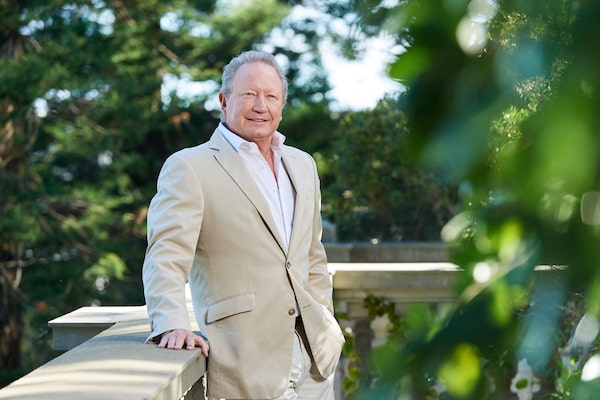
Fortescue Future Industries Chairman Andrew Forrest at the company's office in Perth, Australia on Aug. 12, 2022.FRANCES ANDRIJICH/The Globe and Mail
Australia’s Fortescue Ltd. is touting plans to build a hydrogen project in British Columbia even as the company faces challenges in obtaining limited supplies of hydroelectricity in the province.
East Perth-based Fortescue is seeking regulatory approval to produce “green hydrogen” through a process known as water electrolysis, in which hydrogen is captured as fuel after being split from oxygen. Water would be supplied from the Fraser River for electrolysis at a Prince George industrial site that is located on the traditional territory of the Lheidli T’enneh First Nation.
Green hydrogen is the cleanest version of hydrogen, but it requires huge amounts of renewable energy such as hydroelectricity, and there are also high costs for production.
“The renewable energy will come from BC Hydro and will utilize an estimated 900 megawatts of total power capacity for the electrolysis process,” the BC Environmental Assessment Office said in a recent summary report, in anticipation of receiving a detailed project description from Fortescue.
Australian mining giant looks to Canada for green hydrogen projects
Australian billionaire Andrew Forrest, the founder and executive chairman of Fortescue, has been seeking to diversify the company and transform it into a clean-energy powerhouse. The company’s business includes iron ore mining, formerly under the name of Fortescue Metals Group.
Governments around the world are promoting increased use of hydrogen in transportation and heating as crucial for the planet to achieve the goal of net-zero emissions of greenhouse gases by 2050.
New supplies of hydroelectricity are scheduled to start coming on stream later this year from BC Hydro’s problem-plagued Site C hydroelectric dam in northeast B.C.
Even though the $16-billion Site C project will add 1,100 megawatts of capacity when fully completed, Fortescue’s proposed Coyote hydrogen project in Prince George could consume the equivalent of 82 per cent of the new hydroelectricity.
The company’s Fortescue Canada unit has held a series of briefings over the past two years with key B.C. cabinet ministers and assistant deputy ministers, according to regulatory filings.
The B.C. government said this week that BC Hydro’s 10-year capital plan will have nearly $36-billion in investments, or 50 per cent higher than previously envisaged by the provincial Crown corporation.
“The plan reflects growing demand for electricity across sectors due to population growth and housing construction, increased industrial development, and people and businesses switching from fossil fuels to clean electricity,” the B.C. government said in a statement.
Fortescue is keen to produce hydrogen for domestic consumption and for exporting to Asia, using ammonia as the carrier for hydrogen. Its goal is to have output of 140,000 tonnes a year of green hydrogen and 700,000 tonnes a year of green ammonia.
The B.C. government hopes to create a hydrogen hub in Prince George, including small-scale ventures such as one by Teralta Hydro Solutions Inc.
Teralta said this week that in a partnership with Chemtrade Logistics Inc., it will be producing 4,200 tonnes a year of hydrogen for use by Canfor Pulp Products Inc.
Barry Penner, chair of the newly formed think tank called Energy Futures Initiative, said the BC NDP government needs to proceed cautiously during the energy transition by keeping in mind the role of natural gas. He served as a provincial cabinet minister when the BC Liberals, now named BC United, were the governing party.
Energy Futures Initiative estimates that during the recent cold snap in the province, FortisBC’s natural gas delivered almost twice what BC Hydro’s electricity provided at peak energy usage.
“You can make clean hydrogen through a process known as electrolysis where you run an electric current through water and separate the molecules. But question is where is the electricity going to come from and what energy source are you going to use to generate the electricity,” Mr. Penner said in an interview. “That is the question for all green hydrogen proposals.”
Fortescue emphasizes that the Willow Cale industrial site in Prince George would only require a short transmission line to connect to the nearby Williston substation.
BC Hydro is proposing a North Coast transmission project that would run along the existing route of its B.C. line between Prince George and Terrace.
K’uul Power, a non-profit corporation that is seeking to foster collaboration between First Nations and BC Hydro, estimates 25 per cent of the North Coast’s hydroelectricity demand could be from projects seeking to export liquefied natural gas (LNG). Another 45 per cent might be for producing hydrogen, while the remainder could be earmarked for critical minerals and the Port of Prince Rupert.
Climate activists say the focus should be on renewable energy, and it doesn’t make sense to allocate new supplies of hydroelectricity to help generate fossil fuels such as LNG.
Shell PLC-led LNG Canada, which will be using natural gas-fired turbines in the liquefaction process, plans to start exports to Asia by 2025.
Ksi Lisims LNG is backed by the Nisga’a Nation and Cedar LNG is led by the Haisla Nation. The two projects proposed in northern B.C. hope to utilize hydroelectricity as the power source for supercooling natural gas into liquid form.